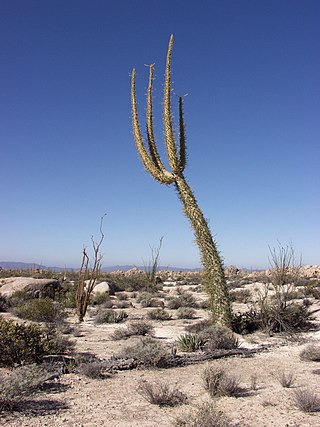
Fouquieria columnaris, the Boojum tree or cirio is a tree in the ocotillo family, whose other members include the ocotillos. Some taxonomists place it in the separate genus Idria. It is nearly endemic to the Baja California Peninsula, with only a small population in the Sierra Bacha of Sonora, Mexico. The plant's English name, Boojum, was given by Godfrey Sykes of the Desert Laboratory in Tucson, Arizona, and is taken from Lewis Carroll's poem "The Hunting of the Snark".

Euphorbia is a very large and diverse genus of flowering plants, commonly called spurge, in the family Euphorbiaceae. "Euphorbia" is sometimes used in ordinary English to collectively refer to all members of Euphorbiaceae, not just to members of the genus.

Euphorbia virosa, the Gifboom or poison tree, is a plant of the spurge family Euphorbiaceae. It has a short main stem, usually twisted, from which 5–10 cm branches emerge. These leafless branches have 5 to 8 edges. Paired thorns grow in regularly spaced intervals from the edges.
Susan Carter Holmes is a botanist and taxonomist. She discovered and catalogued more than 200 plants of the family Euphorbiaceae. Her plants and articles are published under her maiden-name Susan Carter.

Euphorbia atropurpurea, called tabaiba majorera or tabaiba roja in Spanish, is a shrub in the family Euphorbiaceae native to Tenerife in the Canary Islands. It can reach 2 metres in height, and grows in ravines, and on slopes and terraces.
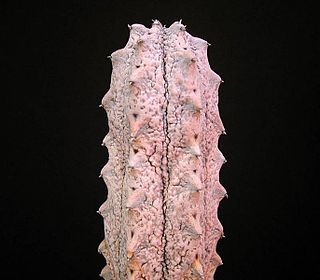
Euphorbia abdelkuri is a species of plant in the family Euphorbiaceae. It is endemic to Abd al Kuri, an island south of Yemen. Its natural habitat is rocky areas. The Latex of the plant is toxic.

Euphorbia misera is a semi-succulent shrub in the genus Euphorbia commonly known as the cliff spurge or coast spurge. A drought-deciduous shrub, it is typically found as a gnarled, straggly plant occupying seashore bluffs, hills and deserts. Like other members of its genus, it has a milky sap, which can be found exuding out of the light gray bark when damaged. The alternately-arranged leaves are round and folded in the middle, with small hairs on them. The "flowers" can be found blooming year-round, and are colored maroon or yellow in the center with 5 white to light-yellow petal-like appendages attached outside. This species is native to the Baja California peninsula and Sonora in Mexico, and the coast of southern California in the United States, where it is a rare species. It is threatened in some localities by the development of its coastal habitat, which tends to be prime locations for high-end residential and commercial developments.

Euphorbia canariensis, commonly known as the Canary Island spurge, Hercules club or in Spanish cardón, is a succulent member of the genus Euphorbia and family Euphorbiaceae endemic to the Canary Islands. It is the plant symbol of the island of Gran Canaria.

Euphorbia poissonii, also known as Euphorbia poissoni and, incorrectly, as Euphorbia poisoni, is a highly irritant and toxic succulent member of the large and varied spurge family of plants. It is native to northern Nigeria, where local farmers extract its latex for use as a pesticide. Its powerfully irritant and pain-producing nature mandates use as a fencing plant. It is known to the Berom people of the Jos area as pyùlúp who transplant it to their compounds where it is regarded as protection against witchcraft.

Euphorbiaceae, the spurge family, is a large family of flowering plants. In English, they are also commonly called euphorbias, which is also the name of the type genus of the family. Most spurges, such as Euphorbia paralias, are herbs, but some, especially in the tropics, are shrubs or trees, such as Hevea brasiliensis. Some, such as Euphorbia canariensis, are succulent and resemble cacti because of convergent evolution. This family has a cosmopolitan global distribution. The greatest diversity of species is in the tropics; however, the Euphorbiaceae also have many species in nontropical areas of all continents except Antarctica.

Euphorbia balsamifera is a flowering plant in the spurge family Euphorbiaceae. It is distributed in the Canary Islands and the western Sahara. It is the vegetable symbol of the island of Lanzarote. Euphorbia adenensis has been treated as a subspecies of this species.
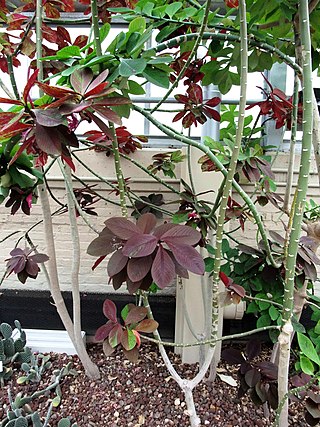
Euphorbia grantii (syn.) Synadenium grantii) is a species of succulent plant in the family Euphorbiaceae, which is native to Africa.

Euphorbia antiquorum, known as antique spurge and "Euphorbia of the Ancients", is a species of succulent plant in the family Euphorbiaceae. It is widespread throughout peninsular India, but its wild origin is obscure. Escaped or naturalized and widely cultivated in neighbouring regions, such as Burma, China, Bangladesh, India, Indonesia, Iran, Malaysia, Myanmar, Pakistan, Thailand, the Philippines, Sri Lanka, and Vietnam, and in many tropical zones worldwide.
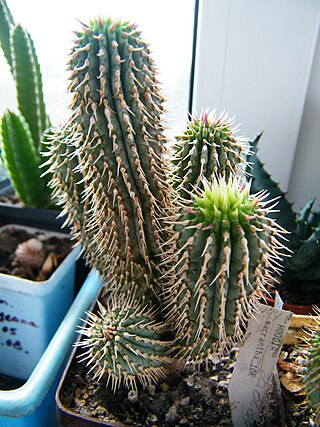
Stem succulents are fleshy succulent columnar shaped plants which conduct photosynthesis mainly through their stems rather than their leaves. These plants are defined by their succulent stems and have evolved to have similar forms by convergent evolution to occupy similar niches.
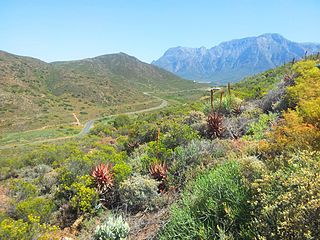
Robertson Karoo is a semi-arid vegetation type, restricted to sections of the Breede River Valley, Western Cape Province, South Africa. It is a subtype of Succulent Karoo and is characterised by the dominance of succulent plant species, and by several endemic plants and animals.
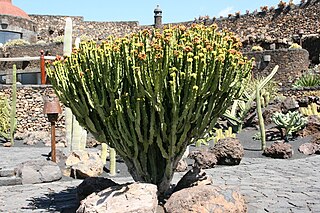
Euphorbia abyssinica, commonly known as the desert candle or candelabra spurge, is a species of plant in the family Euphorbiaceae. E. abyssinica is endemic to Ethiopia, Somalia, Sudan and Eritrea. It was first described in 1791, by the German botanist Johann Friedrich Gmelin. In its native habitat, it can grow up to 10 m (33 ft) tall. The woody stem is used for firewood and as timber in roofing, furniture and other items, and the sap is used in traditional medicine. It is also cultivated as an ornamental house plant.

Euphorbia tuckeyana is a species of flowering plants of the family Euphorbiaceae. The species is endemic to Cape Verde. The species is named after James Hingston Tuckey. Its local name is tortolho. The plants are used for tanning hides. As most other succulent members of the genus Euphorbia, its trade is regulated under Appendix II of CITES.
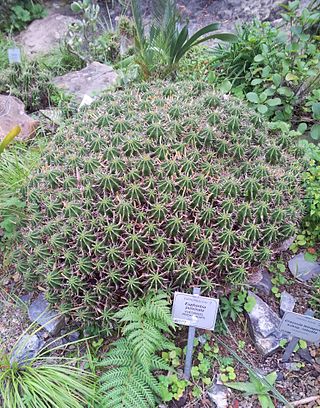
Euphorbia pulvinata, commonly known as the pincushion euphorbia, is a species of plant in the family Euphorbiaceae native to southern Africa.
Euphorbia ampliphylla is a succulent rainforest tree of the montane rainforests throughout East Africa and belonging to the Spurge Family (Euphorbiaceae). The branches are succulent and three-winged and pachycaulous. Like most euphorbs, it has milky white sap. The toxicity of many euphorbs is well known, but no specific information is available concerning E. ampliphylla. It is used locally for medical purposes. It is particularly noted for two things: It is the tallest of all known succulent plants, definitely up to 98 feet and indicated on a carefully scaled diagram as reaching 105 feet. It is also the world's only known succulent rainforest tree.

Euphorbia piscatoria, the fish-stunning spurge, is a species of flowering plant in the spurge family Euphorbiaceae. It is endemic to the Madeira archipelago ]. This species is a shrubby succulent. As most other succulent members of the genus Euphorbia, its trade is regulated under Appendix II of CITES.


















